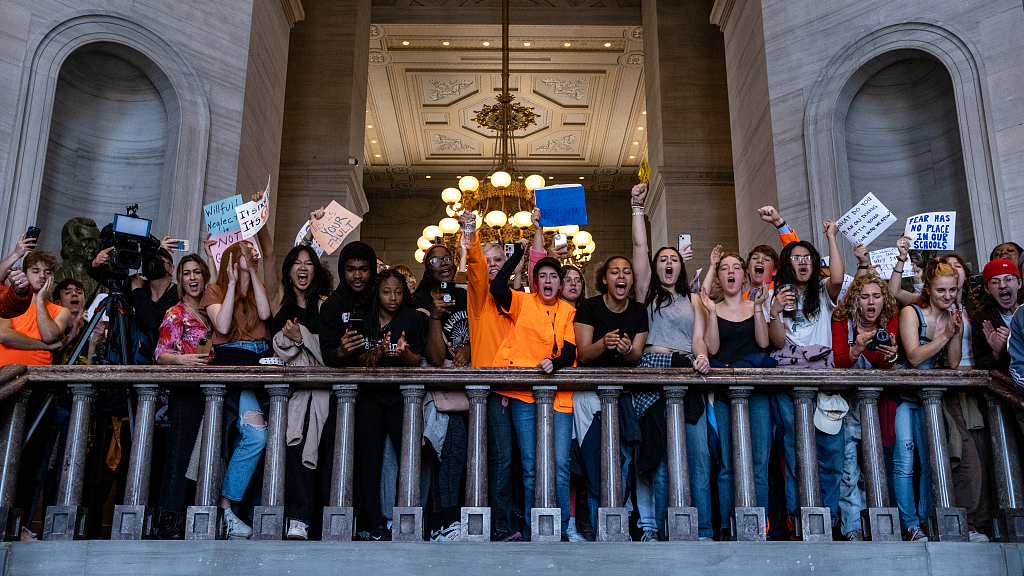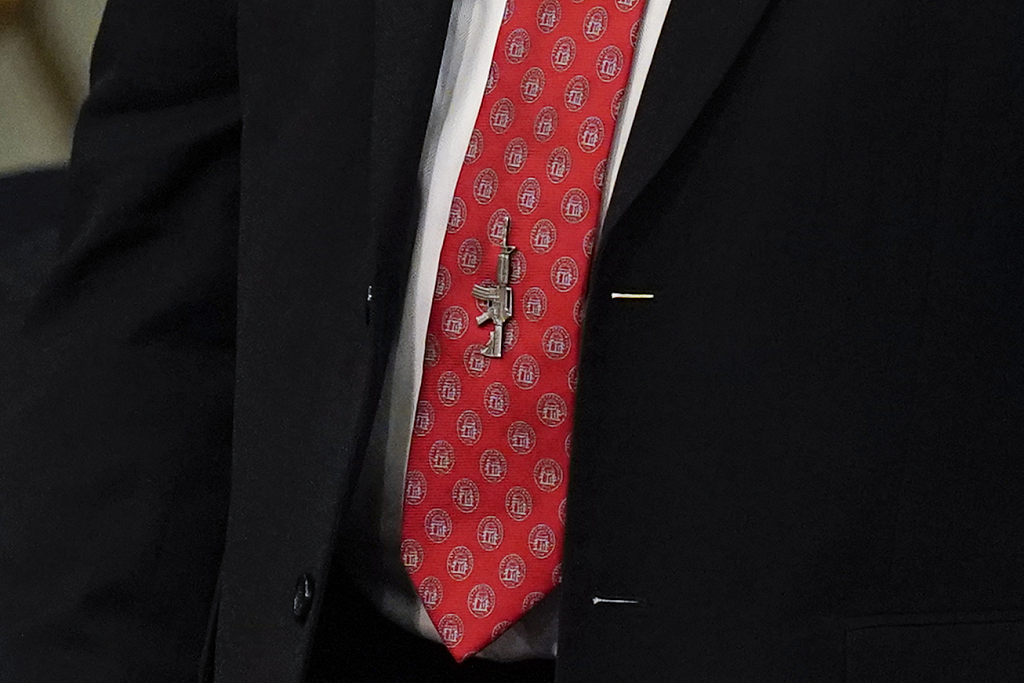
Protesters gather inside the Tennessee State Capitol to call for an end to gun violence and support stronger gun laws in Nashville, Tennessee, U.S., March 30, 2023. /CFP
Protesters gather inside the Tennessee State Capitol to call for an end to gun violence and support stronger gun laws in Nashville, Tennessee, U.S., March 30, 2023. /CFP
Editor's note: Thomas O. Falk is a London-based political analyst and commentator. He holds a Master of Arts in international relations from the University of Birmingham and specializes in U.S. affairs. The article reflects the author's opinions and not necessarily the views of CGTN.
It has become a horrific routine in the U.S.: a murderous gunman uses an AR-15 assault rifle in a massacre that shakes America. What is behind America's deadly fascination with this weapon that causes so much terror and grief?
When World War II veteran Eugene Stoner invented a certain assault rifle, he likely did not envision the havoc it would later bring upon a civilian population. In the 1950s, he worked as an engineer for the small arms manufacturer ArmaLite and sought to develop an assault rifle exclusively for the army, an American answer to the Kalashnikov, the legendary Soviet assault rifle.
He succeeded. During the Vietnam War, the U.S. equipped its soldiers with the M16. A little later, in addition to the M16 for the military, the civilian version was procured, the infamous AR-15.
Today, this weapon is ubiquitous in the U.S. and sales are through the roof as hardly any gun shop window isn't displaying the rifle. Recent estimates from the Washington Post suggest that at least 20 million AR-15s are privately owned in the U.S. and that one in 20 American adults own at least one of these assault rifles.
The AR-15 has achieved a sad cult status in the United States. This killing machine's silhouette has become synonymous with gun lover's proclivity for the Second Amendment, the right to bear arms, and can be found on flags, T-shirts or pins of many Americans, even Congressmen.

Representative Andrew Clyde wears an AR-15 tie tack as he votes for the 10th time in the House chamber as the House meets for the third day to elect a speaker and convene the 118th Congress in Washington, D.C., U.S., January 5, 2023. /CFP
Representative Andrew Clyde wears an AR-15 tie tack as he votes for the 10th time in the House chamber as the House meets for the third day to elect a speaker and convene the 118th Congress in Washington, D.C., U.S., January 5, 2023. /CFP
This cult has deadly consequences, however. The perpetrators of 10 of the 17 deadliest killing sprees committed since 2012 used an AR-15, and the weapon was also used in the most recent tragedy in Nashville, which claimed six victims.
The logical consequence in probably most other rational thinking countries would be banning such weapons. But America's history, beginning with its founding, enshrined a proclivity and passion for guns in the nation's fabric, and the culture of firearms today is as American as Coca-Cola and McDonald's.
This extraordinary, unique, timeless and by now deadly relationship with guns began with the Revolutionary War militias and only grew from there.
In the Wild West, for example, the Winchester rifle became the symbol of the man who defended his family against Indians and wild animals.
However, the mythologized rifle alone does not explain the AR-15's rise; after all, the weapon was initially unsuccessful commercially. Even the powerful gun lobby National Rifle Association (NRA) avoided the semi-automatic weapon, as it was unsuitable for hunting and far too powerful to use against burglars.
But American views changed after September 11, 2001. Soldiers in Iraq and Afghanistan sported their M16s, which created a boom for the civilian version.
Two additional occurrences guaranteed the rifle's lasting success. First, Congress failed to extend the assault rifle ban of 1994 in 2004. Almost every manufacturer began producing their own version of the AR-15, increasing the rifle's presence even further.
Second, with the election of Barack Obama in 2008, AR-15 sales skyrocketed as predominantly white residents of rural areas rushed to the gun, believing that a liberal president would attack the Second Amendment. The gun industry went as far as calling Obama the "gun salesman of the year" in 2009.
Datasupports these points. At the beginning of 2004, the AR-15 accounted for 3.6 percent of all U.S. manufactured guns. By 2020, it accounted for 23.4 percent.
By now, the AR-15 plays a pivotal role in the continuing polarization of American society and its politics. Similar to one's stance on COVID-19 vaccines, for example, the AR-15 has become a political statement that signals to which side of the aisle one belongs, and with the effect that even people who are not gun enthusiasts buy the rifle to affiliate themselves with the sanctuary the weapon has become for America's conservative movement.
These are reasons why Americans' obsession with the AR-15 remains unbreakable and why more massacres are sadly inevitable. Washington will simply repeat its tragic political spiel whereby Democrats demand stricter laws, even a ban, while Republicans obstruct legislation in Congress and offer the victims of massacres their "thoughts and prayers" instead. Meanwhile, the NRA will continue repeating its ill-guided credo: "Guns don't kill people. People kill people," albeit with guns and often an AR-15.
Any rational system would have eradicated the AR-15 for civilian use by now. However, in the U.S., it's celebrated as a symbol of an ancient, obsolete and dangerous cult.
(If you want to contribute and have specific expertise, please contact us at opinions@cgtn.com. Follow @thouse_opinions on Twitter to discover the latest commentaries in the CGTN Opinion Section.)